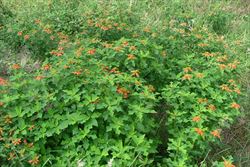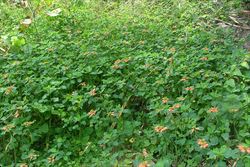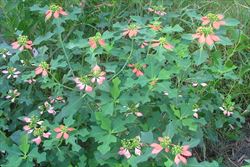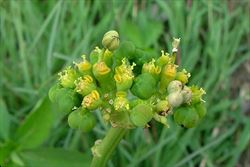Click on images to enlarge

dense infestation near a beach (Photo: Sheldon Navie)

dense infestation along a waterway (Photo: Sheldon Navie)

habit (Photo: Sheldon Navie)

habit (Photo: Sheldon Navie)

fiddle-shaped upper leaves (Photo: Sheldon Navie)

close-up of immature fruit developing from the large three-lobed ovaries (Photo: Sheldon Navie)

close-up of immature and mature and fruit (Photo: Sheldon Navie)

seedlings and young plants (Photo: Sheldon Navie)

comparison of the upper leaves of milkweed (Euphorbia heterophylla), on the left, and painted spurge (Euphorbia cyathophora), on the right (Photo: Sheldon Navie)

'flower' clusters and floral leaves with brightly coloured bases (Photo: Sheldon Navie)

close-up of young 'flowers' (Photo: Sheldon Navie)

comparison of the floral leaves and 'flower' clusters of milkweed (Euphorbia heterophylla), on the left, and painted spurge (Euphorbia cyathophora), on the right (Photo: Sheldon Navie)
Scientific Name
Euphorbia cyathophora Murr.
Synonyms
Euphorbia heterophylla L. (misapplied)Euphorbia heterophylla L. var. cyathophora (Murr.) Griseb.
Family
Euphorbiaceae
Common Names
catalina, dwarf poinsettia, fire on the mountain, fire-on-the-mountain, Mexican fire plant, painted leaf, painted poinsettia, painted spurge, painted-leaf, painted-leaf spurge, poinsettia, summer poinsettia, wild poinsettia
Origin
Native to tropical North America (i.e. the USA and eastern Mexico) and possibly also Central America (i.e. Belize, Costa Rica, Guatemala, Honduras and Panama), the Caribbean and South America (i.e. Bolivia, Colombia, Ecuador, Argentina and Chile).
Cultivation
Painted spurge (Euphorbia cyathophora) is widely cultivated, particularly in the warmer parts of Australia, for its attractive reddish-coloured floral leaves.
Naturalised Distribution
This species has a widespread, but scattered, distribution throughout much of Australia. It is most common in the coastal districts of Queensland and northern New South Wales, scattered in the Northern Territory and in the northern and western parts of Western Australia, and present in the coastal districts of central New South Wales. Also naturalised on several offshore islands (i.e. Lord Howe Island, Christmas Island, Norfolk Island, the Cocos Islands and the Coral Sea Islands) and sparingly naturalised on the Eyre Peninsula in South Australia.
Naturalised in many other parts of the world, including on numerous Pacific islands (e.g. Fiji, French Polynesia, Guam, Hawaii, Kiribati, the Marshall Islands, Nauru, New Caledonia, Niue, Palau and Wake Island).
Habitat
This species is a weed of disturbed sites, waste areas, roadsides, creek banks (i.e. riparian areas) and plantation crops (e.g. sugar cane and pineapples) in tropical, sub-tropical and warmer temperate environments. However, it is most abundant as a weed of coastal environs and offshore islands.
Habit
A short-lived (i.e. annual) herbaceous plant with an upright (i.e. erect) habit. It usually only grows to approximately 70-90 cm in height.
Distinguishing Features
- a short-lived upright herbaceous plant usually less than 1 m tall.
- its stems and leaves have a milky sap.
- its leaves are often fiddle-shaped and are usually alternately arranged along the stems.
- the leaves just below the 'flowers' have reddish-pink coloured bases (i.e. they appear to be 'painted') and can easily be mistaken for large petals at a distance.
- its inconspicuous greenish-coloured 'flowers' are borne at the tips of the branches.
Stems and Leaves
The upright (i.e. erect) stems are 3-5 mm thick and their side-branches, when present, are often produced in pairs. Stems and branches are green in colour and mostly hairless (i.e. glabrous). The stems and leaves also exude a caustic milky sap (i.e. latex) when broken or damaged.
The leaves are oppositely arranged towards the base of the plant, alternately arranged along most of the stem, and are then oppositely arranged again on the uppermost parts of the stems and branches (i.e. where the flowers are produced). These leaves (2-10 cm long and 1-4 cm wide) are borne on stalks (i.e. petioles) 4-12 mm long and the shape of the leaf blade is quite variable. It ranges from fiddle-shaped (i.e. pandurate) or lobed through to oval (i.e. elliptic) or egg-shaped in outline (i.e. obovate). The upper surface of these leaves is hairless (i.e. glabrous) while the under surface usually has a few close-lying (i.e. appressed) hairs. The leaves at the tips of the branches (i.e. those just below the flowers) have reddish-pink coloured bases and can appear to be large flower petals at a distance.
Flowers and Fruit
The inconspicuous 'flowers' (i.e. cyathia) are actually tiny cup-like structures (i.e. involucres) each containing several tiny male flowers and one female flower. The male flowers are reduced to stamens and the female flower consists of a very large stalked ovary topped with a stigma. These 'flowers' (i.e. cyathia) are clustered at the tips of the branches and are yellowish-green in colour. Each 'flower' (i.e. cyathium) is borne on a separate stalk (i.e. peduncle) and the tiny cup-like structures (i.e. involucres) are about 2-2.5 mm long. They usually also have one or two kidney-shaped yellowish structures that contain nectar (i.e. floral nectaries).
The fruit is a three-lobed capsule (3-4 mm long and 5-6 mm wide) with three inner compartments, each containing a single seed. Seeds are egg-shaped (i.e. ovoid) and dark brown in colour (2-3 mm long and about 1.5 mm wide).
Reproduction and Dispersal
Painted spurge (Euphorbia cyathophora) reproduces by seed. The capsules open explosively when mature, expelling the seeds short distances. They may also be spread by water movement and is dumped garden waste.
Environmental Impact
Painted spurge (Euphorbia cyathophora) is regarded as an environmental weed in Queensland and New South Wales. It is ranked among the top 200 environmental weeds in south-eastern Queensland and north-eastern New South Wales, and appears on numerous local environmental weed lists in these regions.
This species prefers sandy soils, particularly in disturbed sites. It is of most concern as a weed of hind-dune areas on beaches and is also relatively common in coastal and sub-coastal riparian zones. In Queensland painted spurge (Euphorbia cyathophora ) is most prevalent in the south-eastern parts of the state, but is also a weed of beaches and offshore islands in the north (e.g. in Townsville City, in Sarina Shire, on Heron Island and on Green Island).
In New South Wales painted spurge (Euphorbia cyathophora) is mainly a problem in coastal sandy sites north of Coffs Harbour on the mid north coast. In Western Australia it is an occasional weed in the northern parts of the state (e.g. at Derby and Broome), has been recorded in suburban Perth, and is also present on offshore islands (i.e. on Koolan Island).
Other Impacts
This species is poisonous to humans. Its stems contain a milky sap (i.e. latex) that is highly irritating when it comes into contact with the skin or when it is accidentally rubbed into the eyes.
Legislation
Not declared or considered noxious by any state government authorities.
Similar Species
Painted spurge (Euphorbia cyathophora) is very similar to milkweed (Euphorbia heterophylla) and poinsettia (Euphorbia pulcherrima). These three species can be distinguished by the following differences:
- painted spurge (Euphorbia cyathophora ) is a relatively small herb (usually less than 1 m tall) with leaves that are sometimes distinctively lobed or fiddle-shaped (i.e. pandurate). The cluster of leaves directly beneath its flowers usually have very distinct bright reddish-pink or orange coloured bases.
- milkweed (Euphorbia heterophylla ) is a relatively small herb (usually 20-80 cm tall) with leaves that are elongated (i.e. lanceolate) or egg-shaped in outline (i.e ovate). The cluster of leaves directly beneath its flowers are usually entirely green in colour, but their bases may be a slightly different colour.
- poinsettia (Euphorbia pulcherrima) is a relatively large shrubby plant (usually 1-3 m tall) with woody stems and leaves that are usually variously toothed or lobed. The cluster of leaves directly beneath its flowers are usually entirely bright red or reddish-green in colour (or occasionally white).

